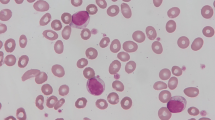Abstract
Large granular lymphocytic leukemia/lymphoproliferative disorder (LGL-L/LPD) is a heterogeneous neoplastic disease of large granular lymphocytes and is a well-known cause of cytopenias. We aimed to reveal the incidence of LGL-L/LPD in patients with cytopenia(s) of unknown etiology (CUE). Twenty-eight patients with CUE were investigated for LGL-L/LPD. T-cell LGL leukemia (LGL-L) was diagnosed in 12 (42.9 %) patients. The frequencies of LGL-L in patients who had anemia, neutropenia, and thrombocytopenia were 9/14 (64.2 %), 11/23 (47.8 %), and 3/10 (30 %), respectively. Seventeen of the 28 patients met the criteria of idiopathic cytopenia of undetermined significance (ICUS), and LGL-L was found in six (35.3 %) of them. We conclude that LGL-L is a rather common disease in patients with CUE and ICUS. It should be considered in this patient group and investigated thoroughly.
Similar content being viewed by others
References
Sokol L, Loughran TP Jr. Large granular lymphocyte leukemia. Oncologist. 2006;11:263–73.
Audemard A, Lamy T, Bareau B, Sicre F, Suarez F, Truquet F, et al. Vasculitis associated with large granular lymphocyte (LGL) leukemia: presentation and treatment outcomes of 11 cases. Semin Arthritis Rheum. 2013;43:362–6.
Sokol L, Loughran TP Jr. Large granular lymphocyte leukemia. Curr Hematol Malig Rep. 2007;2:278–82.
Schiller GJ. Current clinical oncology: chronic leukemias and lymphomas: biology, pathophysiology, and clinical management. In: Benekli M, Baer MR, editors. Large granular lymphocyte proliferative disease. 2003;153–83.
Loughran TP, Xiaopan Y, John MB, Mark RL, Andrew ME, Martin ST. Results of a prospective multicenter phase II study of initial treatment with methotrexate in LGL leukemia (ECOG Protocol E5998). 2010.
Steinway SN, LeBlanc F, Loughran TP Jr. The pathogenesis and treatment of large granular lymphocyte leukemia. Blood Rev. 2014;28:87–94.
Schroeder T, Ruf L, Bernhardt A, Hildebrandt B, Aivado M, Aul C, et al. Distinguishing myelodysplastic syndromes (MDS) from idiopathic cytopenia of undetermined significance (ICUS): HUMARA unravels clonality in a subgroup of patients. Ann Oncol. 2010;21:2267–71.
Dearden C. Large granular lymphocytic leukaemia pathogenesis and management. Br J Haematol. 2011;152:273–83.
Sabnani I, Tsang P. Are clonal T-cell large granular lymphocytes to blame for unexplained haematological abnormalities? Br J Haematol. 2007;136:30–7.
Lamy T, Loughran TP Jr. How I treat LGL leukemia. Blood. 2011;117:2764–74.
Zhang D, Loughran TP Jr. Large granular lymphocytic leukemia: molecular pathogenesis, clinical manifestations, and treatment. Hematol Am Soc Hematol Educ Program. 2012;2012:652–9.
O’Malley DP. T-cell large granular leukemia and related proliferations. Am J Clin Pathol. 2007;127:850–9.
Semenzato G, Zambello R, Starkebaum G, Oshimi K, Loughran TP Jr. The lymphoproliferative disease of granular lymphocytes: updated criteria for diagnosis. Blood. 1997;89:256–60.
Lima M, Almeida J, Santos AH, Dos Anjos TM, Alguero MC, Queiros ML, et al. Immunophenotypic analysis of the TCR-Vbeta repertoire in 98 persistent expansions of CD3(+)/TCR-alphabeta(+) large granular lymphocytes: utility in assessing clonality and insights into the pathogenesis of the disease. Am J Pathol. 2001;159:1861–8.
Posnett DN, Sinha R, Kabak S, Russo C: Clonal populations of T cells in normal elderly humans: the T cell equivalent to “benign monoclonal gammapathy”. J Exp Med. 1994;179:609–18.
Wack A, Cossarizza A, Heltai S, Barbieri D, D’Addato S, Fransceschi C, et al. Age-related modifications of the human alphabeta T cell repertoire due to different clonal expansions in the CD4+ and CD8+ subsets. Int Immunol. 1998;10:1281–8.
Morice WG, Kurtin PJ, Tefferi A, Hanson CA. Distinct bone marrow findings in T-cell granular lymphocytic leukemia revealed by paraffin section immunoperoxidase stains for CD8, TIA-1, and granzyme B. Blood. 2002;99:268–74.
Fortune AF, Kelly K, Sargent J, O’Brien D, Quinn F, Chadwick N, et al. Large granular lymphocyte leukemia: natural history and response to treatment. Leuk Lymphoma. 2010;51:839–45.
Shah A, Diehl LF, St Clair EW. T cell large granular lymphocyte leukemia associated with rheumatoid arthritis and neutropenia. Clin Immunol. 2009;132:145–52.
Go RS, Li CY, Tefferi A, Phyliky RL. Acquired pure red cell aplasia associated with lymphoproliferative disease of granular T lymphocytes. Blood. 2001;98:483–85.
Akashi K, Shibuya T, Taniguchi S, Hayashi S, Iwasaki H, Teshima T, et al. Multiple autoimmune haemopoietic disorders and insidious clonal proliferation of large granular lymphocytes. Br J Haematol. 1999;107:670–3.
Kistangari G, McCrae KR. Immune thrombocytopenia. Hematol Oncol Clin North Am. 2013;27:495–520.
Fogarty PF, Stetler-Stevenson M, Pereira A, Dunbar CE. Large granular lymphocytic proliferation-associated cyclic thrombocytopenia. Am J Hematol. 2005;79:334–6.
Lai DW, Loughran TP Jr, Maciejewski JP, Sasu S, Song SX, Epling-Burnette PK, et al. Acquired amegakaryocytic thrombocytopenia and pure red cell aplasia associated with an occult large granular lymphocyte leukemia. Leuk Res. 2008;32:823–7.
Ergas D, Tsimanis A, Shtalrid M, Duskin C, Berrebi A. T-gamma large granular lymphocyte leukemia associated with amegakaryocytic thrombocytopenic purpura, Sjogren’s syndrome, and polyglandular autoimmune syndrome type II, with subsequent development of pure red cell aplasia. Am J Hematol. 2002;69:132–4.
Dhodapkar MV, Li CY, Lust JA, Tefferi A, Phyliky RL. Clinical spectrum of clonal proliferations of T-large granular lymphocytes: a T-cell clonopathy of undetermined significance? Blood. 1994;84:1620–27.
Valent P. Low blood counts: immune mediated, idiopathic, or myelodysplasia. Hematology Am Soc Hematol Educ Program. 2012;2012:485–91.
Conflict of interest
The authors declare that they have no conflict of interest.
Author information
Authors and Affiliations
Corresponding author
About this article
Cite this article
Bektas, O., Uner, A., Aydin, S.M. et al. High frequency of autonomous T-cell proliferation compatible with T-cell large granular lymphocytic leukemia in patients with cytopenia of unknown etiology. Int J Hematol 102, 211–217 (2015). https://doi.org/10.1007/s12185-015-1816-y
Received:
Revised:
Accepted:
Published:
Issue Date:
DOI: https://doi.org/10.1007/s12185-015-1816-y




